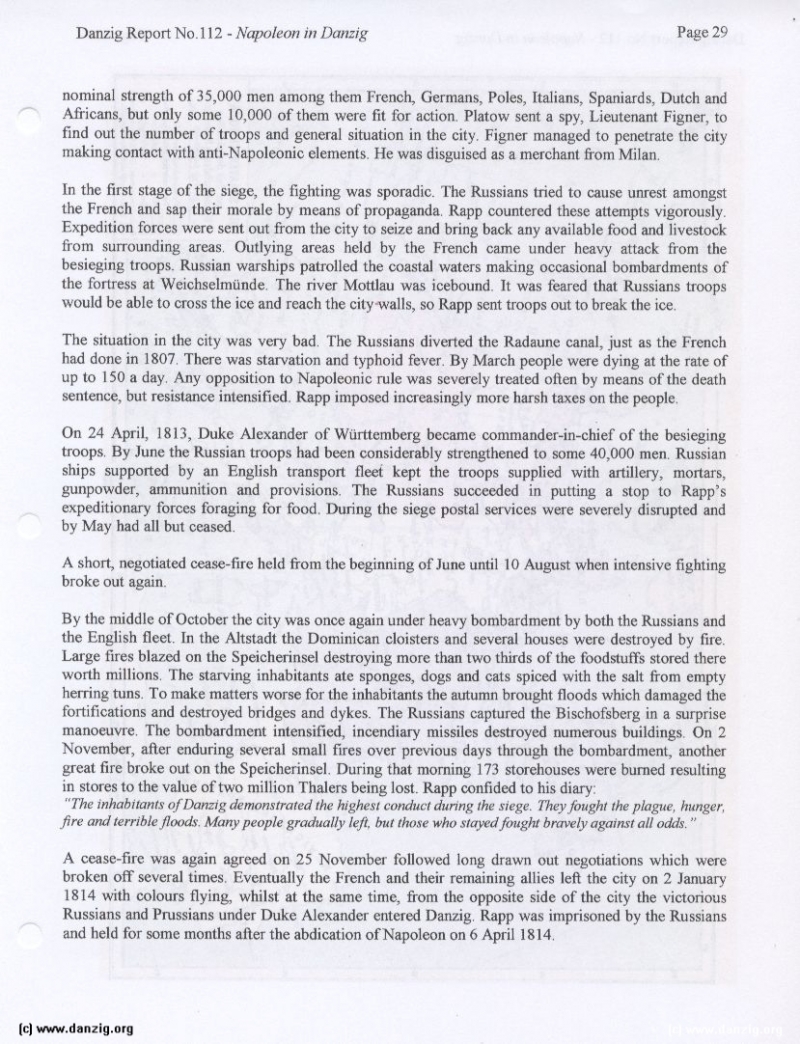
nominal strength of 35,000 men among them French, Germans, Poles, Italians, Spaniards, Dutch and Africans, but only some 10,000 of them were fit for action Platow sent a spy, Lieutenant Figner, to find out the number of troops and general situation in the city. Figner managed to penetrate the city making contact with anti-Napoleonic elements. He was disguised as a merchant from Milan
In the first stage of the siege, the fighting was sporadic. The Russians tried to cause unrest amongst the French and sap their morale by means of propaganda Rapp countered these attempts vigorously. Expedition forces were sent out from the city to seize and bring back any available food and livestock from surrounding areas, Outlying areas held by the French came under heavy attack from the besieging troops Russian warships patrolled the coastal waters making occasional bombardments of the fortress at Weichselmunde. The river Mottlau was icebound It was feared that Russians troops would be able to cross the ice and reach the citywalls, so Rapp sent troops out to break the ice.
The situation in the city was very bad, The Russians diverted the Radaunc canal, just as the French had done in 1807, There was starvation and typhoid fever. By March people were dying at the rate of up to 150 a day. Any opposition to Napoleonic rule was severely treated often by means of the death sentence, but resistance intensified. Rapp imposed increasingly more harsh taxes on the people.
On 24 April, 1813, Duke Alexander of Wurttemberg became commander-in-chief of the besieging troops. By June the Russian troops had been considerably strengthened to some 40,000 men. Russian ships supported by an English transport fleet kept the troops supplied with artillery, mortars. gunpowder, ammunition and provisions. The Russians succeeded in putting a stop to Rapp’s expeditionary forces foraging for food, Dunng the siege postal services were severely disrupted and by May had all but ceased
A short, negotiated cease-fire held from the beginning of June until 10 August when intensive fighting broke out again
By the middle of October the city was once again under heavy bombardment by both the Russians and the English fleet. In the Ahstadt the Dominican cloisters and several houses were destroyed by flue. Large fires blazed on the Speichennsel destroying more than two thirds of the foodstuffs stored there worth millions. The starving inhabitants ate sponges, dogs and cats spiced with the salt from empty herring tuns To make matters worse for the inhabitants the autumn brought floods which damaged the fortifications and destroyed bridges and dykes. The Russians captured the Bischofsberg in a surprise manoeuvre The bombardment intensified, incendiary missiles destroyed numerous buildings On 2 November, after enduring several small fires over previous days through the bombardment, another great fire broke out on the Speicherinsel. During that morning 173 storehouses were burned resulting in stores to the value of two million Thalers being lost. Rapp confided to his diary: “The inhabitants of Danzig denionstrated the highest conthwt during the siege. They fought the plague, hunger, fi, anti ierr,ble floodr. Many people gradually left. but those who slaved fought bravely against all odds.”
A cease-fire was again agreed on 25 November followed long drawn out negotiations which were broken off several times Eventually the French and their remaining allies left the city on 2 January 1814 with colours flying, whilst at the same time, from the opposite side of the city the victorious Russians and Prussians under Duke Alexander entered Danzig. Rapp was imprisoned by the Russians and held for some months after the abdication of Napoleon on 6 April 1814.
Danzig Report Vol. 1 - Nr. 112 - July - August - September - 2001, Page 29.
Hits: 4521
Added: 30/07/2015
Copyright: 2025 Danzig.org

